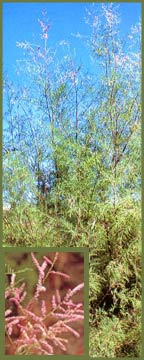Salt Cedar
 Tamarix spp.
Tamarix spp.
It is believed that as many as eight tamarisk species were introduced in the U.S. from Asia for their ornamental values, use in wind breaks or to stabilize eroding stream banks.
Description
General: Salt Cedar is a deciduous, loosely branched shrub or small tree.
Leaves: The leaves are rhombic to ovate, sharply pointed to gradually tapering, and 0.5 - 3.0 mm long. The margins of the leaves are thin, dry and membranaceous.
Stem: Loosely branched, woody stem.
Flowers: Flowers are whitish or pinkish and borne on slender racemes about 25 cm long. They are most abundant between April and August, but may be found any time of the year. Petals are usually retained on the fruit.
Seed/Fruit: Salt Cedar produces massive quantities of small seeds that can complete germination within 24 hours following contact with water. New plants can also be produced vegetatively. Seeds are wind dispersed and also float on water germinating along sandbars and riverbanks.
Habitat
Salt Cedar has become established in flood plains, riparian areas, wetlands and lake margins in the western United States. Salt Cedar has also been found growing in dirt stock tanks, railroad rights-of-way, parks, and upland situations.
Dispersal
Dispersal occurs via wind and down river rafting of seeds. Accidental transport can occur with recreational vehicles, tractors, recreational boating and anglers. Ornamental plantings all serve as dispersal mechanisms. Some of the largest infestations are the result of escapes from urban plantings possibly from the ornamental "Pink Cascade".
Impacts
Salt Cedar invasions displace native plants, trees and wildlife. In some areas as much as 80% of the total cover consists of saltcedar. This has led to dramatic declines in native woody and herbaceous plant composition and abundance.
Salt Cedar's extremely high water usage lowers water tables to levels that can be below the root zone of native trees. It also excretes excess salts through leaf glands, killing plants that are intolerant of saline soils.
It is anticipated that Salt Cedar will cause significant economic damage through lost ecosystem function.
Management
Once Salt Cedar is established it is difficult to control and almost impossible to eradicate. The most successful management method reported involves integrating root ploughing and burning combined with repeated herbicide treatments on re-growth. Mechanical methods including mowing, chaining, ripping, and bulldozing have not been successful.
A classical biological control program has been initiated and shows some potential.
Resources
2011 Rural Municipality Distribution Map
2010 Rural Municipality Distribution Map
Saltcedar or Tamarisk — Project Fact Sheet
Alberta Plant Council Fact Sheet
Â
© Copyright 2004-2024 - CMS Made Simple
This site is powered by CMS Made Simple version 1.4.1


